EVGA Tegra Note 7 Review: Nvidia's Tegra 4 For $200
Nvidia is partnering with EVGA on the company's second Tegra 4-based device. Its Tegra Note 7 sells for $200, sports unique stylus technology, and ships with a bloatware-free build of Android. Can it set a new standard for affordable seven-inch tablets?
Results: Display Measurements
Brightness
The first screen measurements we take are brightness. While the rest of our display measurements, along with our battery testing, is done with the screen set to a standardized light output of 200 nits in order to make device comparison possible, it’s also important to know what your screen is capable of. We record the luminance output of each device using a full white pattern, with the device’s brightness slider set to both minimum and maximum values.
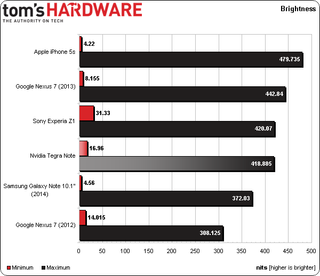
The Tegra Note’s maximum brightness level comes in right around 420 nits, a solid number that should make the tablet quite legible even in daylight. With basically the same maximum brightness as Sony's Xperia Z1, but with half the minimum reading, the Tegra Note should provide better contrast.
Black Level
But before we get to the contrast ratio, we have to calibrate the brightness slider to within one percent of our target 200 nits. While we’re here, might as well check the calibrated black level, or the luminance output of a full black pattern when full white has been standardized.
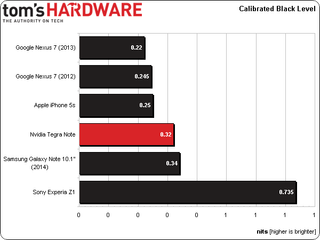
The Tegra Note places just ahead of the Xperia Z1 once again, though by a much higher margin due to the Sony smartphone’s high minimum brightness. This is good showing for the Note.
Contrast Ratio
Now onto contrast ratio, or white pattern versus black.
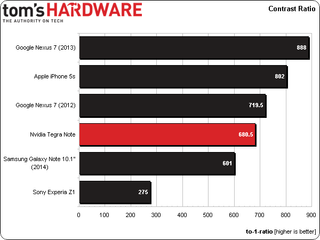
Nvidia’s tablet reads a contrast ratio of approximately 680.5:1, which is a fair score. It’s a tad under last year’s Nexus 7, though as predicted, far better than Sony’s Xperia Z1 despite the two devices having the same maximum brightness.
Color Temperature
Color temperature is a measurement in Kelvin which is used to describe how “warm” a given display is. These are colors derived from the CCT or correlated color temperature. All of the displays tested are in the cool range (basically any temperature above 4000 Kelvin), but the following chart should give some indication of how they tend toward one end or another of the CCT scale.
Stay On the Cutting Edge: Get the Tom's Hardware Newsletter
Get Tom's Hardware's best news and in-depth reviews, straight to your inbox.
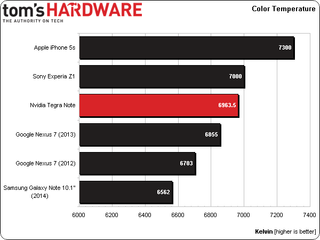
As has been the case since the first iPhone, the iPhone 5s sits at the upper end of the cool spectrum with its whites tending to a cool blue hue. The Xperia Z1 and Tegra Note aren’t far behind either. In fact, out of all devices tested only the Samsung Galaxy Note 10.1 shows any major variance away from intensely blue hues and is more like a traditional PC monitor (most sit at 6500 Kelvin by default).
Gamma
A gamma curve of 2.2, no more, no less is what we optimally want to see.
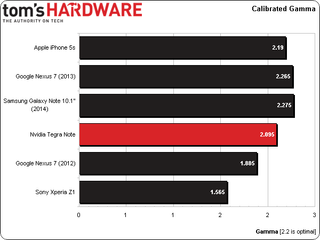
Once again, Apple Retina Display proves to be the best, with an approximate gamma of 2.19! Overshooting the 2.2 target, we have the current Nexus 7 and Galaxy Note 10.1” devices. Back on the lower side of the target we have the Tegra Note at just under 2.1, a quite respectable score, especially compared to the Tegre 3-bearing Nexus 7 (2012) and the abnormal display of the Sony Xperia Z1.
Color Gamut
Our volume measurements are compared against both the sRGB and AdobeRGB color gamuts. A reading of 100% on sRGB and 72% on AdobeRGB is the optimal reading for viewing the vast majority of consumer digital content.
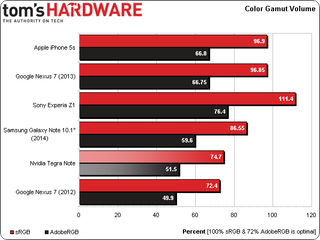
The Retina display of the iPhone 5s runs the closest to the optimal reading, followed closely by the current Nexus 7. The Sony Xperia Z1 overshoots the target, possibly leading to an image with an unintended blue/green tint. The Samsung Galaxy Note 10.1” 2014 Edition is next at an average reading of 85/60. The Tegra Note has the second-worst showing out of today’s comparison devices, followed only by last year’s Nexus 7. At just 74.7 percent of sRGB and 51.5 percent of AdobeRGB, the Note’s screen is closer to that of a cheap laptop screen or desktop monitor than what we’re becoming used to in gadget displays, one of the weaker points of this product.
Overall, the Tegra Note’s screen is OK, but the display on the new Nexus 7 is far superior, and the price difference is just $30.
Current page: Results: Display Measurements
Prev Page Results: Web Browsing Benchmarks Next Page Results: Battery Testing-
DelightfulDucklings Performance wise it is very good for the price seemingly but I just hate the design, to me it just looks plain uglyReply -
JD88 Front facing speakers are really nice. One of the very few complaints I have about my Nexus 7 is volume.Reply
This thing is a powerhouse for the money. -
ananke No 1080p, no sales. Otherwise great device, and good price, but DOA because of the screen. The Chinese knock offs will outsell it.Reply -
TheSchmed I am considering buying this tablet, but I'm weighing it against the less-expensive Dell Venue 7 and 8 (Android, not W8). I hope Tom's will review the Dell tablets and evaluate Intel processor performance and battery life!Reply -
somebodyspecial CF BENCH:Reply
"Sony has been optimising for Snapdragon-based devices since the Xperia range took on the Krait core, and its experience shows as the Xperia Z1 comfortably leads the Tegra Note and Galaxy Note 10.1 in both Managed and Native."
xperia java=32352
Tegra Note7=32648.5
Unless I'm not understanding what is going on here, 32648 is the longer bar/better score right? So while it lost NATIVE, it did not lose Java Managed right? It seems Sony won NATIVE and TEGRA note 7 won Java Managed. You need to fix the text. -
Lessthannil Why does everyone complain about no 1080p? The difference between 1280x800 to 1920X1080p on a 7" screen is minimal while it requires signifigantly more performance and power. Also, its a $199 tablet, what where you expecting?Reply -
JeanLuc While benchmarking did you check to see if the any of the devices you were testing were boosting the SOC clock rates beyond the advertised clock speeds in certain benchmarks? Anandtech looked at this issue a while ago, it would be good to see publications like Toms testing for this sorting of thing and name and shame culprits.Reply -
somebodyspecial Shows the power of the T4, I just wish they'd put it in something I want. And I agree 1080p min on anything that is above a phone' 5in size. But I also understand some just don't care so really a personally complaint about that. I'll wait for T5 and hope they get it into 1080/1200p on 13in or 20in ;) I have no use for 10 or below after using nexus10. Print etc, stuff is just too dang small. Maybe spoiled by 24in/22in dual monitors. I just can do squat on something that small and enjoy it other than some games and I'm not even sure about that. I hope they make a 7in shield 2 :) (maybe a 10in?...LOL).Reply
Smaller and THINNER (you took how much of my batter for thinner?) are USELESS to me. Give me back that larger and FAT model please, so I can run with more power or longer life (or some combo of both). As soon as I see "THINNER" in any description I just put my wallet back and shake my head :( Did I want thinner 10-15 years ago, yeah...Now that party ended ages ago for me.
